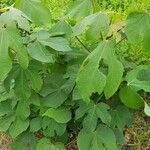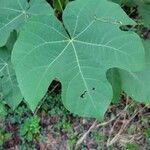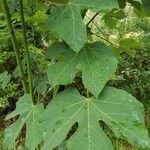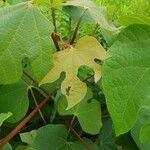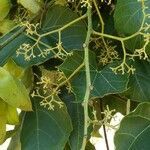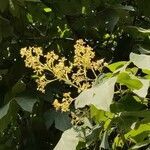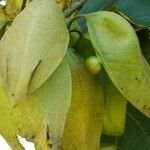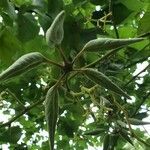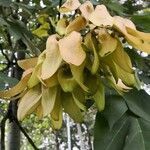Deciduous trees, up to 16 m tall; bark greenish, smooth. Petiole 15-30 cm; leaf blade cordate, palmately 3-5-lobed, 15-30 cm in diam., lobes triangular, both surfaces glabrous or minutely puberulent, basal veins 7, base cordate, apex acuminate. Inflorescence paniculate, terminal, 20-50 cm. Calyx yellowish green, 7-9 mm, divided nearly to base, lobes linear, twisted outward, abaxially puberulent and yellowish, adaxially villous only basally; pedicel nearly as long as calyx. Male flower: androgynophore as long as calyx, thicker in lower part, glabrous. Anthers 15, irregularly fascicled, pistillode pear-shaped and very small. Female flower: ovary globose, hairy. Follicle membranous, stalked, foliaceous, 6-11 × 1.5-2.5 cm, 2-4-seeded, abaxially puberulent or nearly glabrous. Seeds globose, ca. 7 mm in diam., wrinkled. Fl. Jun. 2n = 40*.
A tree. It can have several stems. It loses its leaves during the year. It grows to 20 m high. It spreads 10 m wide. It has smooth bark. It is green but ages to grey. The leaves have 3-7 lobes. They are arranged like fingers on a hand. They are 30 cm across. They turn soft yellow before falling. The flowers are small and cream. They are in large groups on the ends of branches and in the axils of leaves. The fruit are reddish, papery, leaf-like follicles. These split and expose the seeds before they drop.
Tree to 15 m; lvs 8–40 cm long and wide, stellate-hairy on both sides at first, later ± glabrate especially above, the 3–5 lobes sharp-pointed; fls in large mixed panicles to 4 dm; cal-lobes 5, narrow, firm, yellow or white inside, densely stellate outside, spreading-reflexed, to 10 mm, much longer than the tube; follicles thin and flat, to 12 × 5 cm, densely stellate; seeds pea-sized; 2n=50. Native of se. Asia, cult. in se. U.S. n. to Va. and Md., and occasionally escaped. June, July.
